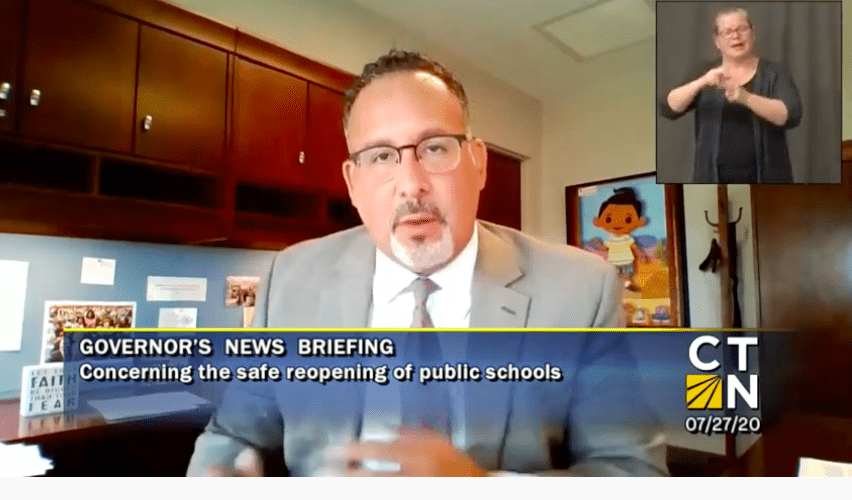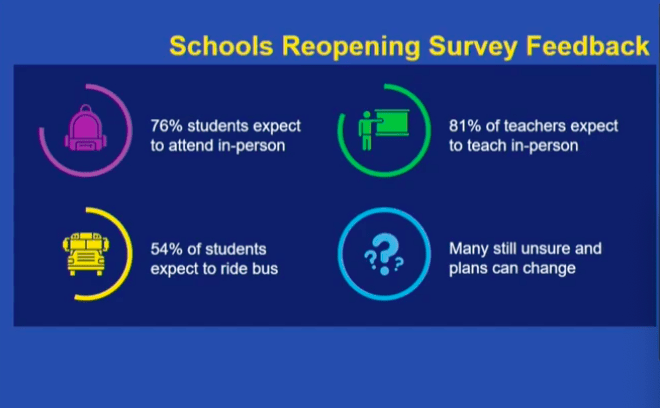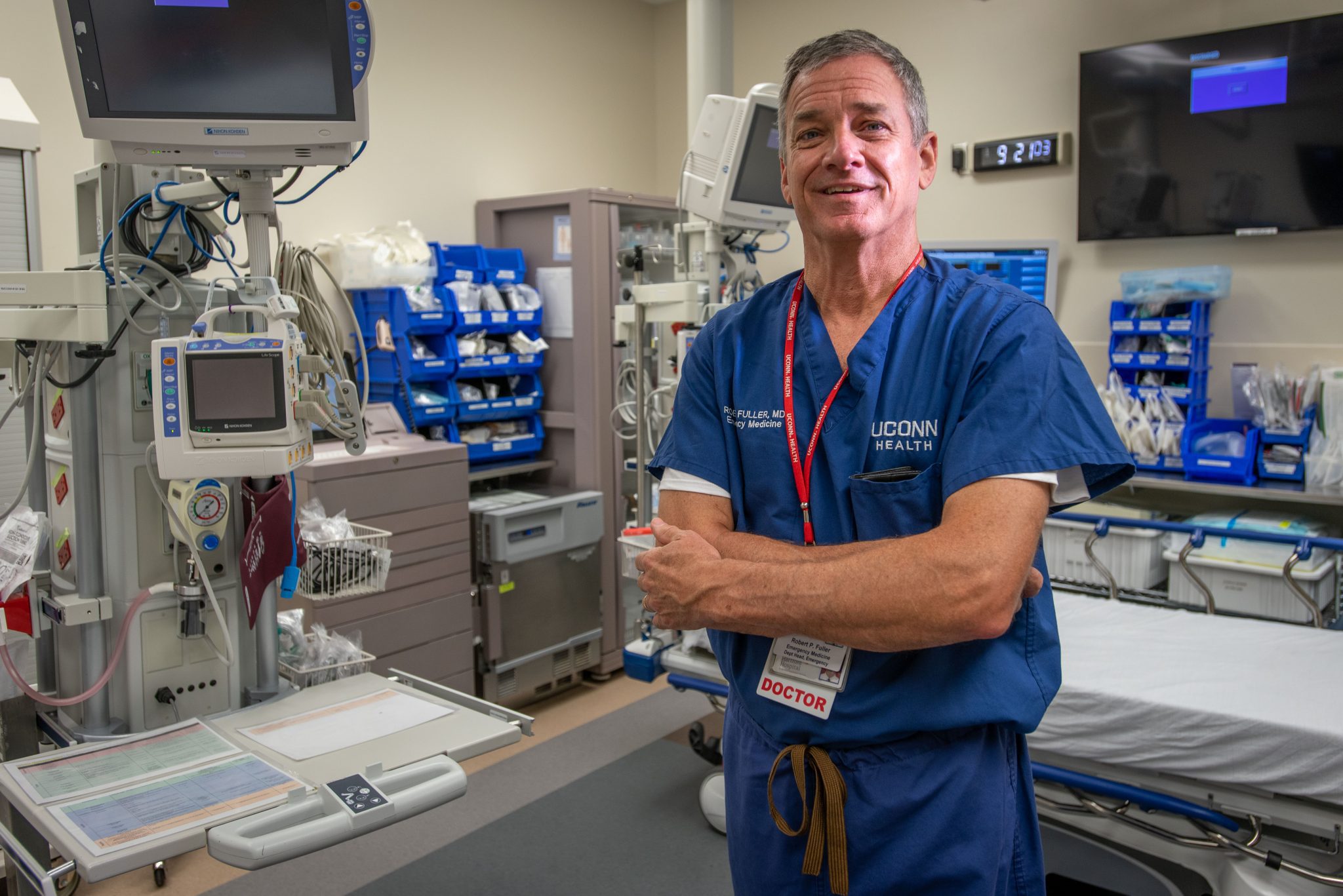Lamont: State Won’t Dictate School Reopening Plan

Audio By Carbonatix

Gov. Ned Lamont speaks about school reopening plans at a press briefing July 27. Screenshot
In West Hartford, about three-quarters of parents have said they plan to send their children back to the classroom for in-person learning if that’s possible, and Gov. Ned Lamont indicated Monday that individual districts, not the state, will make the decision about how to reopen.

Miguel Cardona, commissioner of the Connecticut Department of Education, speaks at a press briefing on July 27. Screenshot
By Christine Stuart, CTNewsJunkie.com
Ronni Newton, We-Ha.com, contributed to this story
Gov. Ned Lamont said a survey of 231 schools found most students and teachers expect to return to the classroom this fall, but contrary to the messages it was sending as recently as last week, the state isn’t going to dictate whether that should happen.
Lamont said he’s heard from districts like Danbury and New Haven who would prefer the hybrid model of in-school and remote learning. Most of the other districts feel comfortable “especially for the lower grades,” to get back to school, Lamont added.

Screenshot of statewide data presented July 27 in Gov. Ned Lamont’s press briefing
Education Commissioner Miguel Cardona said they asked schools to submit three plans, which included a full return to school, a hybrid of online and in-school learning, and a remote learning plan.
“We know distance learning doesn’t make up for in-classroom learning,” Cardona said. “But health and safety will trump whatever decisions are made.”
He said the districts have to feel comfortable with the plans that they have.
“Districts will have to make a determination as to what element of the plan and whether they feel comfortable with a full reopening,” Cardona said.
He said they may decide to fully reopen elementary schools, but not the middle and high schools.
The state won’t be making those decisions.
That was news to some school superintendents.
“This goes against the guidance we have previously received,” West Hartford Superintendent Tom Moore said. “No superintendent has an epidemiologist on staff, so to have 169 superintendents making separate decisions about student health is an abdication of responsibility, just as it was in March when we were forced to make decisions on whether to close with no guidance. We have been provided no metrics on opening or closing.”
Moore, who outlined the district’s three options to the Board of Education last week and sent families a more detailed report on Thursday, said he will do the best he can for the West Hartford community and will rely on local expertise, “but I feel bad for my colleagues who cannot tap into parents who are also medical experts.”
A survey of West Hartford parents taken in the first few weeks of July found 75% plan to send their children to school while 8.5% plan on home schooling and 16.5% are uncertain.
Lamont said it might have been a misunderstanding that the state planned to mandate how school districts would reopen in the fall.
“Every town, every city has very different metrics,” Lamont said. “The vast majority will be able to have in-classroom especially for the lower grades.”
Cardona said any parent in Connecticut has the right to keep their child home and receive learning from home.
Lamont’s executive authority runs out in September and he’s going to ask for an extension unless the legislature wants to regulate everything he’s had to regulate since the pandemic began.
Earlier this month the state Department of Education issued guidance to local school districts before asking them to submit their plans for the state to review.
The guidance requires 177 days of school. It also says that if a school has to cancel classes due to the changing public health data they will be expected to provide full access to educational programming remotely.
The order would take the form of a statewide emergency if an outbreak is geographically concentrated.
The plan goes on to define the new “cohorting” term as a group or team of students and educators with consistent members that stay together throughout certain periods of the school day. The purpose of the cohort model is to limit the number of students who are exposed to COVID-19 if there is community transmission in the school, and assist with effective contact tracing. While there is no definitive numerical restriction on cohort size, cohorts should be kept as stable as practicable.
State officials said they would continue to offer guidance to local school districts.
Parents across the state are struggling with many of the same questions, and the idea of sending their children back to school.
“I lean toward my daughter returning, but that will depend on national infection rates, not just those in Connecticut,” said Michelle Manafy, a Shepaug Valley School parent who attended a recent school board meeting to advocate for the hybrid model to be deployed at the combined middle and high school in Washington, in rural Litchfield County.
She believes the full in-person option is not only a health risk, but a waste of time and money.
“There is no way for our schools to come near the 6-foot requirement,” for social distancing, she said. “The planning for how to do lunches alone will eat up untold energy and time that could better be spent on providing the resources teachers and educators need to prepare to do their jobs in the fall. Our teachers will spend less time enforcing social distancing and more time educating.”
AnnMarie Sarbello, who volunteered to serve on the reopening committee for Shepaug Valley School where her son will be a junior this year, favors a hybrid model that would reduce the number of students in classes, as well as on buses, in hallways and at lunch.
Teachers, she said, would still have the in-classroom opportunity to help students struggling with distance learning, and to develop plans to help those students both in school and remotely. She said she would consider holding her son out of school if she doesn’t like the local plan.
“Unfortunately, the full model greatly increases everyone’s exposure,” more than what the state allows for indoor dining, businesses or grocery stores, said Sarbello, a certified teacher who works at an elementary school library. “We should certainly hold our schools and the safety of our children and educators to an equal, if not higher, standard.”
Karena Garrity and Steve Jensen also contributed to this report.
Republished with permission from CTNewsJunkie.com, all rights reserved.
Like what you see here? Click here to subscribe to We-Ha’s newsletter so you’ll always be in the know about what’s happening in West Hartford! Click the blue button below to become a supporter of We-Ha.com and our efforts to continue producing quality journalism.




[…] During a press briefing Monday, July 27, Gov. Ned Lamont said that as long as the metrics will permit in-person learning, the districts could choose from between the full reopening and the hybrid option. […]